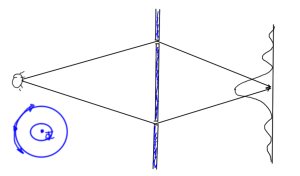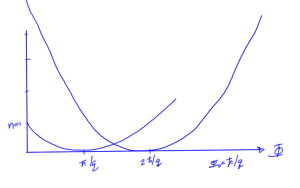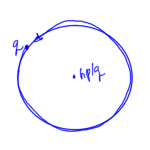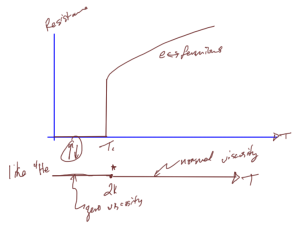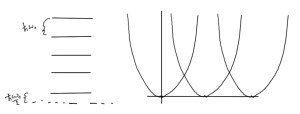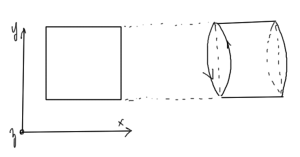[Click here for a PDF of this post with nicer formatting]
Disclaimer
Peeter’s lecture notes from class. These may be incoherent and rough.
These are notes for the UofT course PHY1520, Graduate Quantum Mechanics, taught by Prof. Paramekanti, covering [1] chap. 2 content.
problem set note.
In the problem set we’ll look at interference patterns for two slit electron interference like that of fig. 1, where a magnetic whisker that introduces flux is added to the configuration.
Aharonov-Bohm effect (cont.)
Why do we have the zeros at integral multiples of \( h/q \)? Consider a particle in a circular trajectory as sketched in fig. 3
FIXME: Prof mentioned:
\begin{equation}\label{eqn:qmLecture7:20}
\phi_{\textrm{loop}} = q \frac{ h p/ q }{\Hbar} = 2 \pi p
\end{equation}
… I’m not sure what that was about now.
In classical mechanics we have
\begin{equation}\label{eqn:qmLecture7:40}
\oint p dq
\end{equation}
The integral zero points are related to such a loop, but the \( q \BA \) portion of the momentum \( \Bp – q \BA \) needs to be considered.
Superconductors
After cooling some materials sufficiently, superconductivity, a complete lack of resistance to electrical flow can be observed. A resistivity vs temperature plot of such a material is sketched in fig. 4.
Just like \ce{He^4} can undergo Bose condensation, superconductivity can be explained by a hybrid Bosonic state where electrons are paired into one state containing integral spin.
The Little-Parks experiment puts a superconducting ring around a magnetic whisker as sketched in fig. 6.
This experiment shows that the effective charge of the circulating charge was \( 2 e \), validating the concept of Cooper-pairing, the Bosonic combination (integral spin) of electrons in superconduction.
Motion around magnetic field
\begin{equation}\label{eqn:qmLecture7:140}
\omega_{\textrm{c}} = \frac{e B}{m}
\end{equation}
We work with what is now called the Landau gauge
\begin{equation}\label{eqn:qmLecture7:60}
\BA = \lr{ 0, B x, 0 }
\end{equation}
This gives
\begin{equation}\label{eqn:qmLecture7:80}
\begin{aligned}
\BB
&= \spacegrad \cross \BA \\
&= \lr{ \partial_x A_y – \partial_y A_x } \zcap \\
&= B \zcap.
\end{aligned}
\end{equation}
An alternate gauge choice, the symmetric gauge, is
\begin{equation}\label{eqn:qmLecture7:100}
\BA = \lr{ -\frac{B y}{2}, \frac{B x}{2}, 0 },
\end{equation}
that also has the same magnetic field
\begin{equation}\label{eqn:qmLecture7:120}
\begin{aligned}
\BB
&= \spacegrad \BA \\
&= \lr{ \partial_x A_y – \partial_y A_x } \zcap \\
&= \lr{ \frac{B}{2} – \lr{ – \frac{B}{2} } } \zcap \\
&= B \zcap.
\end{aligned}
\end{equation}
We expect the physics for each to have the same results, although the wave functions in one gauge may be more complicated than in the other.
Our Hamiltonian is
\begin{equation}\label{eqn:qmLecture7:160}
\begin{aligned}
H
&= \inv{2 m} \lr{ \Bp – e \BA }^2 \\
&= \inv{2 m} \hat{p}_x^2 + \inv{2 m} \lr{ \hat{p}_y – e B \xhat }^2
\end{aligned}
\end{equation}
We can solve after noting that
\begin{equation}\label{eqn:qmLecture7:180}
\antisymmetric{\hat{p}_y}{H} = 0
\end{equation}
means that
\begin{equation}\label{eqn:qmLecture7:200}
\Psi(x,y) = e^{i k_y y} \phi(x)
\end{equation}
The eigensystem
\begin{equation}\label{eqn:qmLecture7:220}
H \psi(x, y) = E \phi(x, y) ,
\end{equation}
becomes
\begin{equation}\label{eqn:qmLecture7:240}
\lr{ \inv{2 m} \hat{p}_x^2 + \inv{2 m} \lr{ \Hbar k_y – e B \xhat}^2 } \phi(x)
= E \phi(x).
\end{equation}
This reduced Hamiltonian can be rewritten as
\begin{equation}\label{eqn:qmLecture7:320}
H_x
= \inv{2 m} p_x^2 + \inv{2 m} e^2 B^2 \lr{ \xhat – \frac{\Hbar k_y}{e B} }^2
\equiv \inv{2 m} p_x^2 + \inv{2} m \omega^2 \lr{ \xhat – x_0 }^2
\end{equation}
where
\begin{equation}\label{eqn:qmLecture7:260}
\inv{2 m} e^2 B^2 = \inv{2} m \omega^2,
\end{equation}
or
\begin{equation}\label{eqn:qmLecture7:280}
\omega = \frac{ e B}{m} \equiv \omega_{\textrm{c}}.
\end{equation}
and
\begin{equation}\label{eqn:qmLecture7:300}
x_0 = \frac{\Hbar}{k_y}{e B}.
\end{equation}
But what is this \( x_0 \)? Because \( k_y \) is not really specified in this problem, we can consider that we have a zero point energy for every \( k_y \), but the oscillator position is shifted for every such value of \( k_y \). For each set of energy levels fig. 8 we can consider that there is a different zero point energy for each possible \( k_y \).
This is an infinitely degenerate system with an infinite number of states for any given energy level.
This tells us that there is a problem, and have to reconsider the assumption that any \( k_y \) is acceptable.
To resolve this we can introduce periodic boundary conditions, imagining that a square is rotated in space forming a cylinder as sketched in fig. 9.
Requiring quantized momentum
\begin{equation}\label{eqn:qmLecture7:340}
k_y L_y = 2 \pi n,
\end{equation}
or
\begin{equation}\label{eqn:qmLecture7:360}
k_y = \frac{2 \pi n}{L_y}, \qquad n \in \mathbb{Z},
\end{equation}
gives
\begin{equation}\label{eqn:qmLecture7:380}
x_0(n) = \frac{\Hbar}{e B} \frac{ 2 \pi n}{L_y},
\end{equation}
with \( x_0 \le L_x \). The range is thus restricted to
\begin{equation}\label{eqn:qmLecture7:400}
\frac{\Hbar}{e B} \frac{ 2 \pi n_{\textrm{max}}}{L_y} = L_x,
\end{equation}
or
\begin{equation}\label{eqn:qmLecture7:420}
n_{\textrm{max}} = \underbrace{L_x L_y}_{\text{area}} \frac{ e B }{2 \pi \Hbar }
\end{equation}
That is
\begin{equation}\label{eqn:qmLecture7:440}
\begin{aligned}
n_{\textrm{max}}
&= \frac{\Phi_{\textrm{total}}}{h/e} \\
&= \frac{\Phi_{\textrm{total}}}{\Phi_0}.
\end{aligned}
\end{equation}
Attempting to measure Hall-effect systems, it was found that the Hall conductivity was quantized like
\begin{equation}\label{eqn:qmLecture7:460}
\sigma_{x y} = p \frac{e^2}{h}.
\end{equation}
This quantization is explained by these Landau levels, and this experimental apparatus provides one of the more accurate ways to measure the fine structure constant.
References
[1] Jun John Sakurai and Jim J Napolitano. Modern quantum mechanics. Pearson Higher Ed, 2014.
